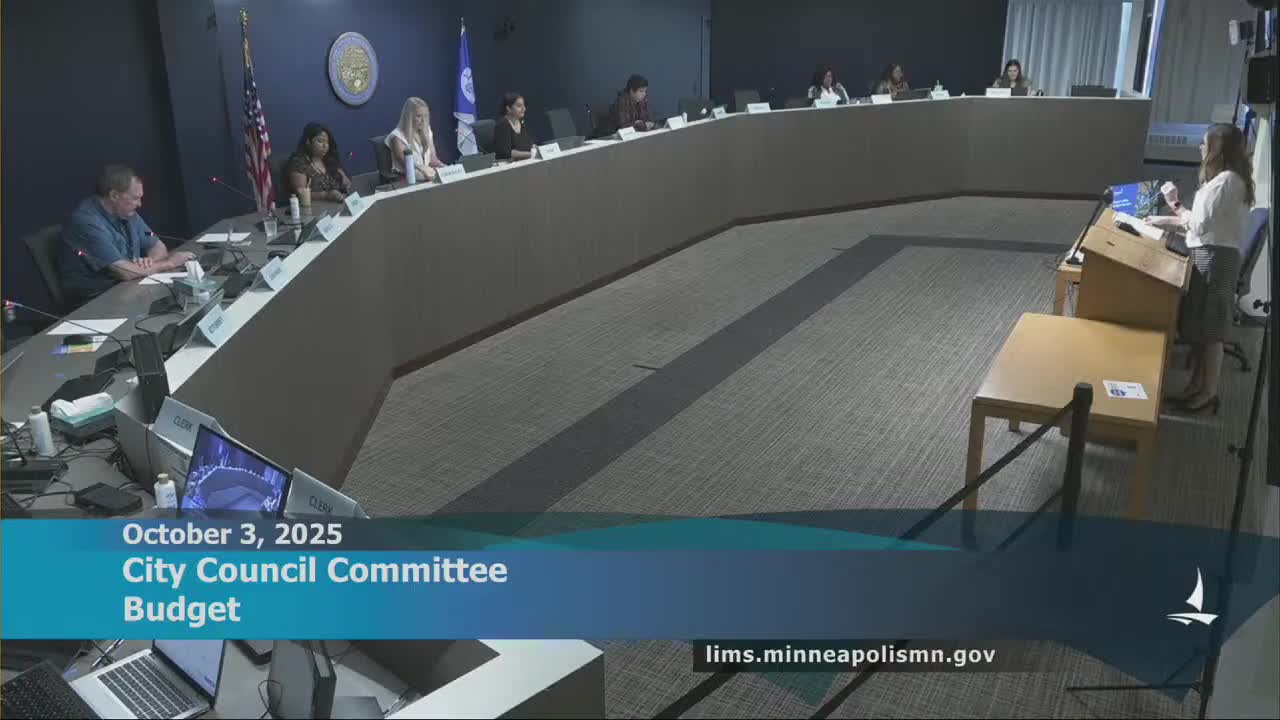Mayor’s chief of staff outlines 2026 priorities, modest budget cut and accessibility gains
October 04, 2025 | Minneapolis City, Hennepin County, Minnesota
This article was created by AI summarizing key points discussed. AI makes mistakes, so for full details and context, please refer to the video of the full meeting. Please report any errors so we can fix them. Report an error »

Grace Waltz, chief of staff in the Office of Mayor Jacob Frey, gave the Budget Committee a brief overview of the mayor’s office organization, priorities and recommended 2026 budget on Oct. 3.
“The mission of our office is very simple, to improve the daily lives of Minneapolis residents and to provide clear and consistent direction to the cabinet and administrative departments,” Waltz said, describing three office verticals — operations, communications and policy — and the office’s work on constituent services and scheduling.
Waltz told committee members the office is holding steady at 16 FTEs, that it is fully staffed and that the mayor’s recommended budget includes a $22,900 ongoing reduction achieved through internal reclassifications. Year-to-date constituency contacts exceed 7,000 across calls, email and online submissions, and the office has handled nearly 800 meeting requests for the mayor this year, she said.
Nut graf: The presentation emphasized process and transparency improvements rather than program expansions. Waltz highlighted a new resident-facing mayoral priorities dashboard, an updated intake process for event and meeting requests, and expanded recognition tools. Committee members asked finance staff to clarify operating cost drivers tied to internal service charges and actuarial liability allocations.
Waltz described the new dashboard as an internal tool adapted for public use to show trends across mayoral priorities, including community safety, hiring and homeless response. “We kept the focus on metrics that the city has some level of control over,” she said, adding that the dashboard intentionally limits metrics to those subject-matter experts say are meaningful.
When Council Member Wansley asked about an operating-cost increase that appeared on slides, Jane Desensa, budget director, said that the item reflected higher internal service charges driven by an actuarial liability report and litigation-related allocations that had been centrally held in the mayor’s office.
Waltz closed by noting capacity risks across the enterprise. She said attracting and retaining employees remains a challenge and is a continuing priority for the mayor’s office.
The committee had no formal vote on the presentation; the clerk filed the mayor’s office presentation for the record.
“The mission of our office is very simple, to improve the daily lives of Minneapolis residents and to provide clear and consistent direction to the cabinet and administrative departments,” Waltz said, describing three office verticals — operations, communications and policy — and the office’s work on constituent services and scheduling.
Waltz told committee members the office is holding steady at 16 FTEs, that it is fully staffed and that the mayor’s recommended budget includes a $22,900 ongoing reduction achieved through internal reclassifications. Year-to-date constituency contacts exceed 7,000 across calls, email and online submissions, and the office has handled nearly 800 meeting requests for the mayor this year, she said.
Nut graf: The presentation emphasized process and transparency improvements rather than program expansions. Waltz highlighted a new resident-facing mayoral priorities dashboard, an updated intake process for event and meeting requests, and expanded recognition tools. Committee members asked finance staff to clarify operating cost drivers tied to internal service charges and actuarial liability allocations.
Waltz described the new dashboard as an internal tool adapted for public use to show trends across mayoral priorities, including community safety, hiring and homeless response. “We kept the focus on metrics that the city has some level of control over,” she said, adding that the dashboard intentionally limits metrics to those subject-matter experts say are meaningful.
When Council Member Wansley asked about an operating-cost increase that appeared on slides, Jane Desensa, budget director, said that the item reflected higher internal service charges driven by an actuarial liability report and litigation-related allocations that had been centrally held in the mayor’s office.
Waltz closed by noting capacity risks across the enterprise. She said attracting and retaining employees remains a challenge and is a continuing priority for the mayor’s office.
The committee had no formal vote on the presentation; the clerk filed the mayor’s office presentation for the record.
View full meeting
This article is based on a recent meeting—watch the full video and explore the complete transcript for deeper insights into the discussion.
View full meeting
